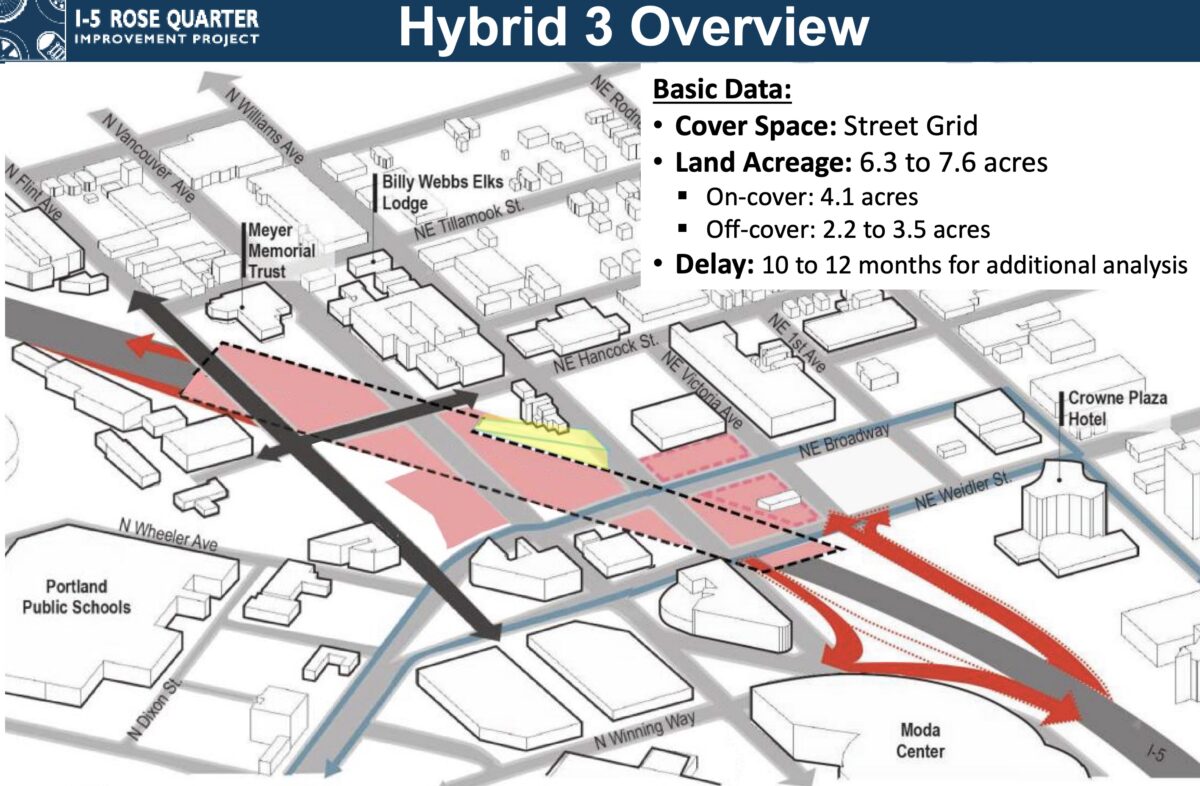
15 months after they walked away in opposition to the I-5 Rose Quarter project, the nonprofit Albina Vision Trust is now back at the table.

The shift comes after Oregon Governor Kate Brown brokered a compromise that will give a massive boost to the Oregon Department of Transportation’s project, while also forcing them to spend more money and take more time to develop more and taller buildings on future freeway caps.
While much of the attention on this project revolves around the width of the freeway and whether it should be expanded at all, Albina Vision Trust (AVT) has spent years with a laser-focus on the caps issue. As we reported in February 2019, ODOT’s initial plan was to cover I-5 with relatively anemic caps that would only support a park with minimal structures (at right). That wasn’t acceptable to AVT because their plan is to rebuild the neighborhood (which was destroyed by the construction of the freeway and other developments) with a dense grid of streets and dwellings.
Both ODOT and AVT have hired consultants to examine what type of caps are possible. ODOT had dragged their heels on the issue due to fears that the expense and construction of caps that would meet AVT’s standards would cause delays and jeopardize the project.
The caps issue was so critical to AVT that they pulled support for the project in June 2020. When ODOT lost AVT, they didn’t just lose a key nonprofit partner, they also lost support of many local and regional elected officials who had hitched their wagons to AVT. This big thorn in ODOT’s side was separate from the vast amount of opposition ginned-up by No More Freeways and their supporters.
Advertisement
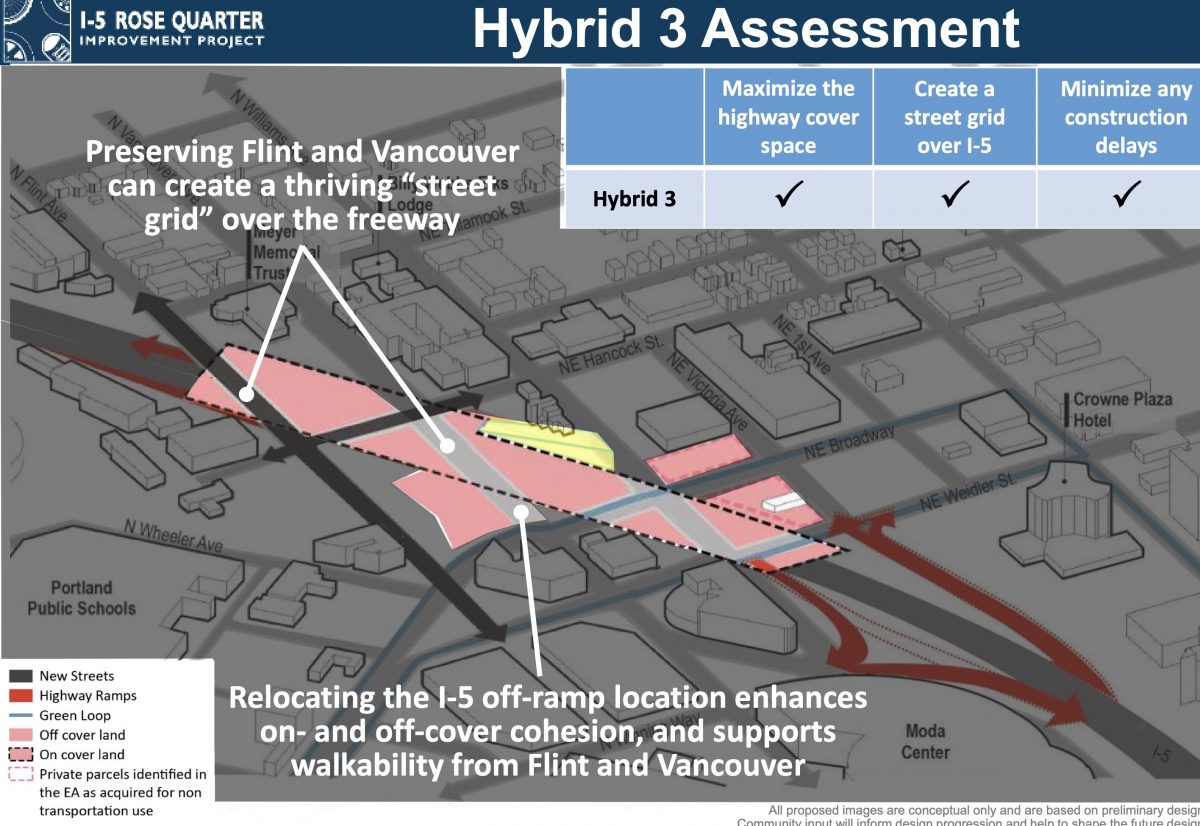
Expanding I-5 through the Rose Quarter is ODOT’s top priority project. Something had to give.
The first light at the end of the tunnel appeared for ODOT back in June when Oregon’s congressional delegation made it clear there would be federal funding for more robust caps.
Then last week ODOT announced that Governor Brown visited Portland in early July to tour the Rose Quarter and, “Gain a better understanding of the community concerns that have arisen over the course of the Independent Cover Assessment work and facilitate a path forward between the many interests from the community.”
“Now we can move forward with a project that will provide good jobs, create community wealth building opportunities and repair the urban fabric in the heart of the city.”
— Winta Yohannes, Albina Vision Trust
Brown then stopped by a joint meeting of the project’s three advisory committees Tuesday night to unveil a “win-win” compromise on the caps that both ODOT and AVT had agreed to.
“The Rose Quarter project is perhaps the largest Disadvantaged Business Enterprise contracting opportunity in the state,” Brown said, making it clear the economic impact of the project is paramount for her. “It’s incredibly important to me that we find a path forward that can preserve the contracting opportunities.” Brown said a cap option known as Hybrid 3 will be the chosen one moving forward. “Hybrid 3 represents a compromise we’ve all been looking for. It addresses safety, congestion and environmental concerns of project, providing a canvas for development opportunities, along with project timeline that can leave existing contract opportunities in place.”
Reached for comment this morning AVT Executive Director Winta Yohannes praised Governor Brown and called her compromise a “historic consensus”. “This clears the path for Oregon’s federal delegation to fight for the federal funds intended to reconnect communities and build safer urban transportation systems,” read a statement from the group.
AVT blamed “ODOT’s failure to build consensus” as the main threat to progress and said this new compromise would not have been possible without the Governor stepping in. “She literally snatched victory out of the jaws of defeat,” Yohannas said. “Now we can move forward with a project that will provide good jobs, create community wealth building opportunities and repair the urban fabric in the heart of the city.”
ODOT project staff at last night’s meeting said the more robust caps envisioned in the Governor’s deal could hold buildings 2-5 stories high and would add 10-12 months of delay to the $800 million project; but they won’t stop the project from moving forward. The cost of the caps is estimated to be around $300 million.
Also at last night’s meeting, Governor Brown said she supports moving Harriet Tubman School to a new location so it’s not adjacent to an even wider interstate freeway.
ODOT says a formal recommendation of the Hybrid 3 cap option from the Oregon Transportation Commission has been pushed back to this fall.
It’s unclear what all this means to No More Freeways and their lawsuits against the project. They’ve now lost a key opposition partner and the consensus around moving Harriet Tubman School removes one of their key points of contention with the project. We’ve reached out to them and will report back.
UPDATE:No More Freeways Co-founder Chris Smith says, “In general I think we believe this is better for the community than the EA [Environmental Assessment] design, but we still believe a full EIS [Environmental Impact Statement] is appropriate and are not intending to terminate any of our legal actions.”
UPDATE, 4:34 pm: More from No More Freeways Co-founder Chris Smith:
“No More Freeways believes Governor Brown’s endorsement of the Hybrid 3 cover design represents a significant improvement over the original ODOT design from the 2019 Environmental Assessment. We congratulate Albina Vision Trust on their successful efforts to demand that ODOT invest in reconnecting the Albina neighborhood and generate wealth and opportunity for Portland’s Black community, and we continue to be inspired by their leadership and moral clarity.
Of course, it is not necessary to widen I-5 through the heart of the historic Black neighborhood in order to cover the freeway. No More Freeways believes that the substantial air pollution, carbon emissions and induced traffic impacts of the additional lanes have yet to be honestly accounted for by ODOT. We will continue to push for a full Environmental Impact Statement in the courts and other venues to ensure ODOT is held accountable for the impacts this proposed expansion will have on our community’s lungs and our warming planet.”
— Jonathan Maus: (503) 706-8804, @jonathan_maus on Twitter and jonathan@bikeportland.org
— Get our headlines delivered to your inbox.
— Support this independent community media outlet with a one-time contribution or monthly subscription.


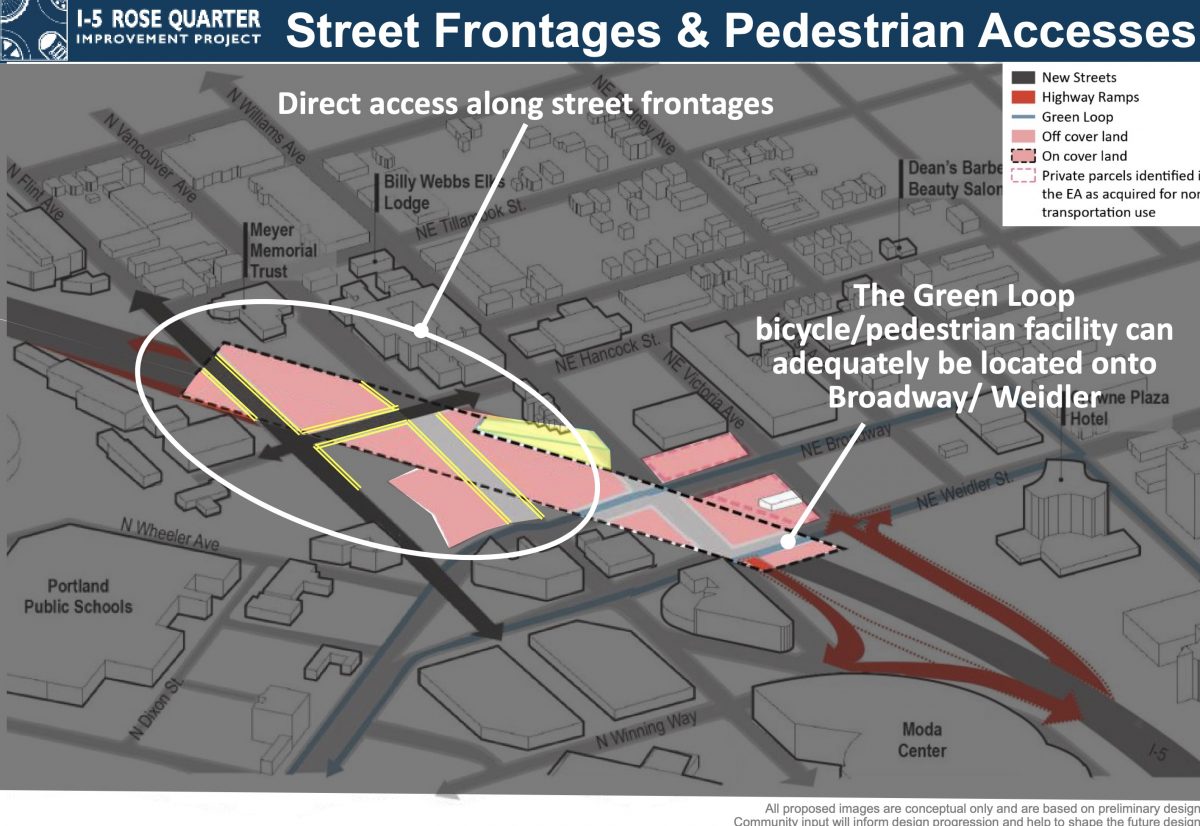
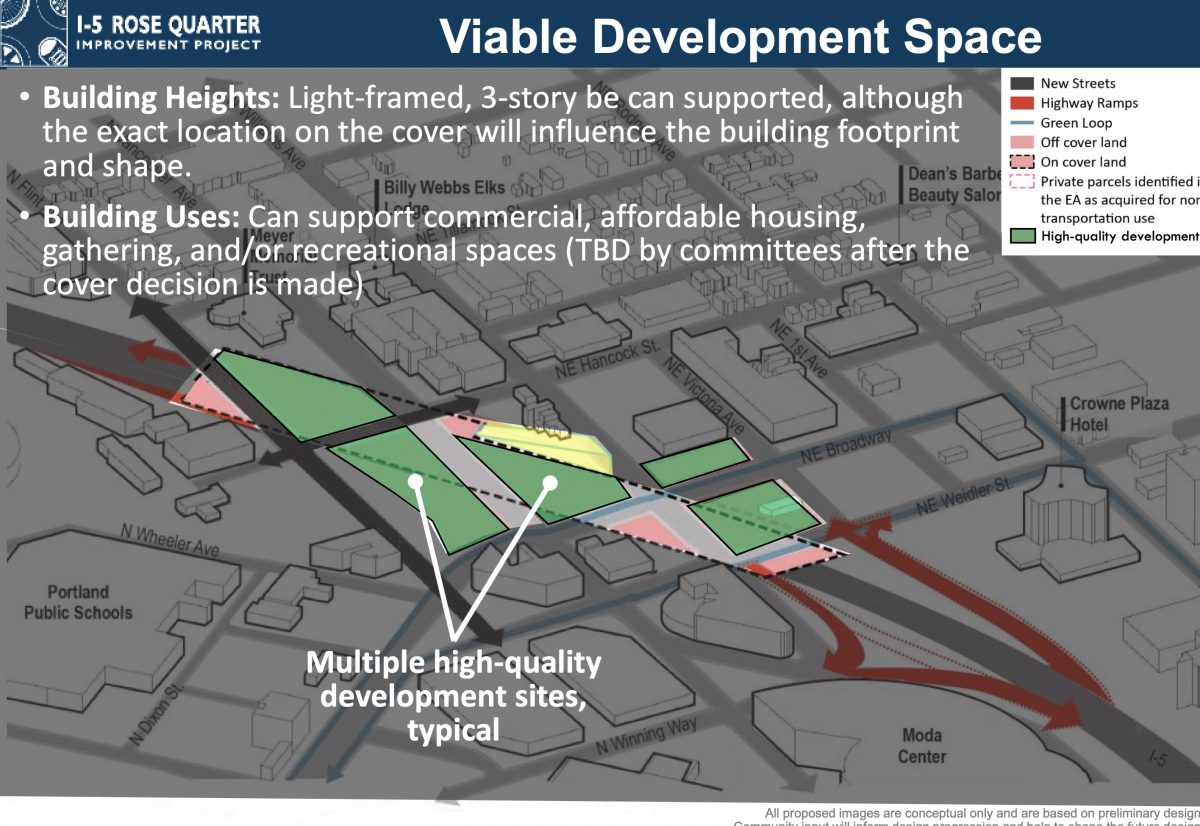

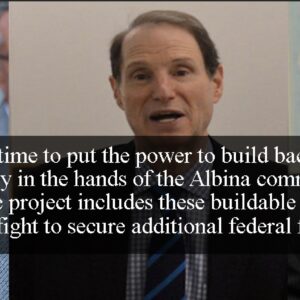
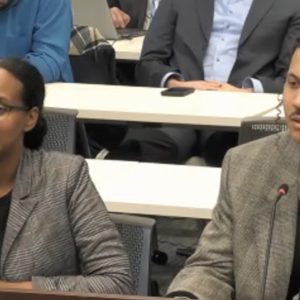

Thanks for reading.
BikePortland has served this community with independent community journalism since 2005. We rely on subscriptions from readers like you to survive. Your financial support is vital in keeping this valuable resource alive and well.
Please subscribe today to strengthen and expand our work.
Getting rid of that offramp that dumps traffic onto southbound vancouver seems like a great start, but it looks like it may dump the traffic onto williams northbound instead.
Bury the whole thing!
It’s ironic that an organization that calls itself “No More Freeways” seems to be tacitly supporting a freeway expansion.
Soren, No More Freeways continues to oppose all freeway expansions in the Metro region, including this one. We were just at Metro yesterday opposing widening of 217 and I-205 (and now have one Councilor on our side).
But at the same time we deeply respect the work of AVT to reconnect and rebuild their community. The changes in design are a win for their goals and we can’t ignore that.
The caps could be built, and the ramps relocated, without widening the freeway. NMF and AVT are not in opposition to each other. ODOT’s strategy is to pit community groups against each other, as they have with AVT and the Black Contractors. We refuse to be pulled into their tactics.
“No More Freeways continues to oppose all freeway expansions in the Metro region, including this one”
If NMF genuinely opposes this particular freeway expansion then, by definition, NMF opposes the hard fought deal between AVT and Governor Brown. To be frank, I don’t believe the above bravado. This particular bit of sausage making has been very well-telegraphed and it’s a virtual certainty that you, Aaron, and Joe have seen this coming so I will make a prediction: NMF won’t actively oppose this freeway expansion and the law suits will soon be quietly abandoned.
“NMF and AVT are not in opposition to each other.”
I agree. AVT is your coalition partner and NMF now has an obligation to at least tacitly support this particular freeway expansion deal.
No More Freeways fully intends to move forward with the lawsuits, but since you’re making all these bold predictions, I’m curious, Soren: what do you think No More Freeways should do in response to this development? You seem to have a lot of grumpy proclomations and bizarre inferred statements about us – what do you believe is the right course of action at this moment?
I think NMF should insist on closing the underground ramps.
This pictures above do not at all define what the YELLOW is or the RAMPS. What these pictures don’t show is the volume of traffic coming off these ramps AND THE DISRUPTION TO THE NEIGHBORHOOD. We absolutely should close the ramps and cap them. Closing the ramps will free up congestion without widening. All of those trips can be diverted to on and off ramps elsewhere. Albina Vision Trust is not representing all the other Indigenous people who have a claim to that land and ACCESS TO THE RIVER.
It’s more affordable to cap the 405 and remove I-5 from the East Side. Resist anything else. Shame on Brown and Shame on AVT for excluding the voices of Indigenous.
I just donated a bunch of money to NMF so they can take the legal path. I hate courts and attorneys so good luck. LMK when the next freeway shut down is if that don’t work.
I want to second Roberta’s call to remove the ramps!
You mean to another neighborhood? Whose neighborhood would absorb all of these trips?
Exactly. Unless the plan is to tear down to Moda Center, these ramps are exactly where they should be. Do we really want people exiting I-84 at 12th and driving through Lloyd, or exiting I-5 at Going St. to the north or Water Ave to the south, and then driving on our surface streets to get to the Moda parking garages?
“what do you think No More Freeways should do in response to this development”
Decide whether or not you are going to oppose the deal and make a clear public statement. (Think deeply about “coalition” politics and expected outcomes.)
Edit:
I find the continued focus on ODOT and not on ODOT’s boss — the real villain in this fight — and the wishy washiness of “accountability” to be disappointing.
I’ve also put Aug 5th 2022 in my calendar app and will re-up this thread then.
“grumpy”
Despite the mild ad hominem, I’m not particularly grumpy about this development. As I’ve commented at length here and elsewhere (over many years), I think this particular campaign sucked the oxygen out of local transportation emissions activism even though it would have done nothing to lower existing emissions. IMO, a focus on new emissions is the activism we needed in the 1980s, not the kind of activism we need now in the 2020s when many tens of millions of lives (predominantly outside of the USA) are threatened by ongoing ecocide.
i wasn’t alive in 1980, so i’m sorry i didn’t take on much activism back then. and we emailed hundreds of letters to Governor Brown and have testified at nearly every Oregon Transportation Commission meeting over the past years, so I’m surprised by your assertion we aren’t properly going after the “real villian” in this fight.
We’ve made it pretty clear: No More Freeways support caps, if they meet the standards that Albina Vision demands, and we oppose extra lanes of freeway. We’re not the ones insisting that caps and freeways are a package deal – that’s ODOT, the OTC and Governor Brown.
“i wasn’t alive in 1980”
OK millenial.
“so I’m surprised by your assertion we aren’t properly going after the “real villian” in this fight.”
Your org spent enormous capital vilifying a puppet bureaucracy and commission (that almost no one cares about) while largely sparing the political establishment that exerts complete and total control over that bureaucracy. How many times has your coalition held protests at Tina Kotek, Peter Courtney, or Kate Brown’s house* as opposed to holding another easily ignored protest at ODOT headquarters. The democratic party is your enemy, not ODOT.
*the symbolic governor’s mansion in salem is not kate brown’s house
I disagree that calling out ODOT is a “puppet bureaucracy and commission” – there is in fact a freeway industrial complex that has deep reach into these agencies, and calling this out and naming it is crucial for establishing the link between fossil fuel infrastructure and the agencies that promote it.
I actually agree with the general assertion that there is a need for more direct antagonism towards the elected officials who promote these projects, and i encourage you to stay tuned in the weeks and months ahead.
I also think it’s pretty disappointing to see how dismissive you are of the youth climate strike outside the Governor’s mansion, considering it was orchestrated almost entirely by 15 year olds who aren’t even old enough to drive, and it was successful enough to get dozens of people (and press) out to the Governor’s office 70 miles away. We’re doing all of this on our own time, we’re learning as we go along, and I’m deeply proud of how influential our coalition of climate/transportation/public health reformers have shifted the conversation about freeway expansion, even if we still have so much farther to go, given our limited budget and capacity (and given the enormous resources of our opponents).
You’re welcome to host your events, Soren, if you’re so certain of your tactics and analysis, although given your general approach to organizing and collaborating with like-minded individuals I’d be curious to see how successful you’d be in drawing others to your cause.
It’s August 5th 2023 now. Just wondering… did your calendar app fail to give you a notification?
The changes in the design had nothing to do with AVT. The fact is that AVT has been obfuscating the whole time and unwilling to put their cards on the table. The new design was pushed by ODOT and its advisory committees as a reasonable path forward compromise to maximize the developable land while keeping to a the schedule as much as possible. Buildable covers have been under design consideration for months. It was only Gov. Brown who could drag AVT to the table. The definitely don’t deserve any credit here.
AVT demanded caps:
https://www.oregonlive.com/commuting/2021/05/rose-quarter-freeway-meeting-punctuated-by-talk-of-distrust-jobs-restorative-justice.html
And they got them:
Yohannes: “Now we can move forward with a [freeway expansion] project that will provide good jobs, create community wealth building opportunities and repair the urban fabric in the heart of the city.”
This is good news. These caps are far more sensible and usable than the ones ODOT initially proposed.
But I still think a far more sensible solution would be to make I-405 the through route, remove the eastbank freeway, and use single-bore tunnels to connect the west end of I-84 to I-5 N, I-5 S, and US 26 W. In all, about 10 miles of single-bore tunnel would be required. The cost would be similar to the Rose Quarter project, and traffic flow would arguably be much better. ODOT’s been approaching this project with blinders from the start…
Please provide citations for your claim that the cost of 10 miles of single-bore tunnel would be similar to the Rose Quarter project.
The Seattle tunnel project cost more than $3.3 billion and was 1.7 miles long. Based on that cost per mile, your 10 mile tunnel would be over $20 billion. That’s not even in the ball park of the Rose Quarter estimate.
Seattle encountered several serious technical problems with their tunnel that drove costs way up and might have been avoided with better planning. For local tunneling costs a good place to start would be to look at the costs of the BES ‘Big Pipe’ project, it was installed in a geological environment near the Willamette River similar to that which any freeway tunnels would be likely to encounter.
I don’t think a 20ft diameter sewer pipe is comparable to a buried freeway project. Maintaining the same lane capacity that we currently have on I-5 would require TWO tunnels roughly the same size as the Bertha tunnel in Seattle, and both tunnels would need to go under the river. Boston’s Big Dig would be a better comparison.
BES Big Pipe: $1.4 billion (early 2000s dollars)
Seattle 99W: $3.3 billion
Boston Big Dig: $21.5 billion (2020 dollars adjusted for inflation)
I would guess we’d be looking at $10 billion to “bury” I-5 between the South Waterfront and the Rose Quarter. It would be better to just remove I-5 in that section, re-sign I-405 as I-5 add 1 through lane in each direction between SW Montgomery and NW Glisan, and add buildable caps.
With the above complete, the Rose Quarter expansion is no longer needed. 2 through lanes is more than enough to feed I-84 traffic into the Rose Quarter and onto the Fremont Bridge. The remaining lane on I-84 west would exit onto MLK.
Burying I-5 is a non-starter. With all the ramps and merge points, it’s just not practical. I agree 100% that it should be removed. However, I don’t think it’s a workable solution to have the section of I-405 between Goose Hollow and the Fremont bridge carrying all the N-S traffic, all the E-W traffic, and the NB to EB & WB to SB ramps.
That’s why direct exit ramps in tunnels would be needed, to take the east-west traffic and the ramp traffic. I do think you’re probably right that double-bores wouldn’t work–a stacked single tunnel with one lane in each direction (~40′ diameter) would probably be the way to go.
How do you figure it would cost the same? On the low end, a tunnel in the U.S. costs $600 million per mile.
Okay, I ran some numbers and I did exaggerate a bit. My idea would probably cost about twice as much, but it would also resolve the Fremont bridge bottleneck (that will be another billion dollar project when ODOT needs to replace it).
Here’s how I figure: The Alaska way project was a 57.5′ diameter tunnel. Single bore tunnels would be ~20′, or 12% of the volume. $3.3 billion / 1.7 * 0.12 = $230 million. That jives fairly well with the Seattle Link University LRT project, which came in at $300 million per mile (that’s for a single bore – $600 million a mile for both bores). Highway tunnels are typically a bit less than transit tunnels. There could be some economies of scale that would drive costs down too. Heck, see if Elon Musk’s boring company would take it on (I know, he’s a jerk, but maybe they could actually deliver). Anyway, seems like an idea that should have at least been considered.
*Marquam bridge, not Fremont.
A 20-foot diameter tunnel would accommodate only a single lane! Better start over.
Correct, that’s why I said ten miles of single-bore tunnel. It would be five miles with a larger bore, which actually would probably be more cost effective.
Highway tunnels and light rail tunnels are very different. Highway tunnels require additional room for breakdown, and contain flammable materials operated by untrained drivers, requiring additional ventilation and egress paths.
The boring company is a joke. Their “Tesla tunnels” cost more per passenger mile than any form of public transit, because the capacity is pathetic. You can’t run even a single lane of traffic in a 20ft diameter tunnel, because you have no breakdown or egress space.
You can build a tunneling machine to any size you want, a 30′ bore should be adequate for non-commercial traffic and accommodate ventilation and other safety features but probably would not accommodate tractor trailer trucks. In the end the actual cost can’t be estimated without a more detailed geotechnical study; for example, tunneling through hard rock or large cobbles and gravel would almost certainly be harder and more expensive than tunneling through unconsolidated sands and silts. In fact, if the city were to do this, the geotechnical work should definitively be considered when selecting the location/route, and it will probably be controversial wherever it might be located, ’cause that’s the Portland way.
No one wants to recreate on non-buildable caps, because this entire area is just a sewer of auto traffic. These spaces would just turn into more camps. The city and Metro should accept nothing less than fully buildable caps for the entire project zone.
Whatever is built on the cap(s) is going to have the collected emissions from the buried freeway pumped overhead and falling on the streets and buildings. If we’re lucky, ODOT will filter and scrub that exhaust. With even more luck, they’ll maintain those scrubbers in good working condition. Feeling lucky? I’m not.
In the early days of discussion of this project this was pointed out, but has barely been mentioned since. I recall that the cost of scrubbing and ventilation was a big motivator to push smaller unbuildable caps.
A true Big Dig type tunnel would have the potential for treating the air before it hits the neighborhoods.
I agree with the Governor. Seems like a win-win. It will restore a great walkable, bikable community (with a buildable cap) AND reduce congestion. I do hope the whole cap is buildable. We don’t want a lot of very expensive “camping plazas”. That would be very disappointing.
I hope the new cap proposal truly ends up with modest urban density of 5 floors (= to DC & Paris density) and not low density almost suburban 2 story…
“the caps are, “estimated to cost between $1.1 billion and $1.16 billion — the vast majority of the project’s total cost”
Roughly two city blocks reclaimed, for $1.1-1.6 billion. The most expensive real estate on earth, by miles and miles. Incredible. Is this actually the best way that a billion dollars could be spent for the benefit of the community displaced from the Albina area, and the communities now being displaced from other parts of Portland?
No. The best way money could be spent would be tearing out that section of concrete and putting parks and housing back in.
That piqued my curiosity. The highest land sale price (not including sunk costs like Chernobyl or Fukushima) I could find offhand is $935 million for 1.25 acres in Hong Kong ( $185,000 per square meter). So, the 4.1 covered acres at Hong Kong prices would be worth about $3,000,000,000 (give or take some tens of millions).
Monaco land at about $60,000 per square meter is also noted frequently, bringing those four lidded acres to around $1 billion in that market.
While “miles and miles” is an exaggeration, Portland isn’t Hong Kong or Monaco, and John’s point stands. Would that money bring actual justice to the people and community displaced from Albina? Could it be spent differently with better results? (housing?) What would the cost per acre of “new” land pencil out at if I-5 were razed from the Fremont to the Marquam?
(And then what would happen with car traffic currently served by that inner SE piece of I-5? More surface traffic to 84, 405 or 205? And would that move push a drive for a west-side loop freeway?)
Is that what this is really about? The way I see it is this: The Rose Quarter would be prime real estate if it wasn’t for I-5. The two end results of this project are that ODOT widens I-5 through the Rose Quarter with unbuildable caps resulting in shanty towns that will make the area even more avoidable than it is or ODOT builds buildable caps.
There is a lot of empty space in the Rose Quarter and it’s close to everything. The only reason that it hasn’t been filled with lux apartments is because of the cluster and noise created by I-5. If buildable caps are installed, this neighborhood will rapidly gentrify. It’s just too close in and well connected to services not to.
I really see it as a question of live-ability. Either we build the caps and gentrify this part of Portland or we keep them uncapped and keep the neighborhood relatively affordable but subject the people who live there to all the negative externalities of living next to an interstate.
I can’t see this project actually benefitting Black Portlanders in any real way. It’s going to end up being a ritzy area with plaques about Black history.
a few things…
The expenditure amount is a factor; $300M has different implications than $1.5B.
Yes, social (particularly racial) justice is a factor. AVT brought it to the table under that lens, and I can see how their vision fits the circumstances.
“Shanty towns” aren’t a sustainable first world urban feature. It’s boggling that our society and economy have taken so long to face that issue. Factoring them into a 50-year infrastructure plan accepts defeat.
I absolutely agree about the value of the location, and the detriment of the freeway. That, and the welfare of the city as a whole, is why I’m interested in razing east bank I-5.
As for how Black Portlanders might view the benefits of this project, with or without caps, – and I don’t think we are in disagreement about that, either – I think Champs said it very well.
I have no idea where you are getting that quote. It certainly isn’t in this article, which states above that the caps are only $300 million:
He got that number from this post. I deleted it a few hours after publishing (I got it from an AP report, but was told by a source it wasn’t accurate). I should have made this correction more carefully. Sorry.
Good catch, Chris. (& thx for confirming, Jonathan) I’d zap my post if I could, though I am still interested in a comprehensive plan to move I-5 off the east bank.
FWIW I’m super excited that the Honorable Kate Brown is actually looking at the interchange critically. I would like to point out that one of the largest employer in the Lloyd Center is the State of Oregon buildings. This “anchor” of employees should be REQUIRED TO ride the Max line that is like a red carpet to the building. Letting them out of riding the Max by providing easy access and state subsidized parking spaces. As far as I’m concerned those Administration buildings have never undergone a proper travel demand management plan, where you work with each employee and help them find more sustainable or remote working options.
FYI – Jacinda in New Zealand forced her employees to undergo a wage hike furlough to stave off inflation. It’s a great idea. Instead here in Oregon the state employees gave themselves a 15% raise plus a bunch of hazard pay bumps. The Democratic elected officials just bought themselves the next AFSCME and OPEU/SEIU bought and sold election. They are just lining their pockets with insane salaries; aka the Oregon DOG or Treasury. That’s insane. Why they (state estimators) keep under biding tax hauls remains a mystery but every time these pork barrel projects don’t undergo any scrutiny. Just union pay bumps.
Stop the madness, close the ramps and reduce the price of the project by like 40% and still be amazing. I mean honestly Albina should start a beach resort for Black healing. Why oh why put it on a freeway?
The FWP has now gone pretty much where I expected, a squishy billion plus dollars which I will not be surprised to see hit one point five. A number I have never seen is how much concrete will be needed to build this but I guess that number just went up by about 50%. People: this is a big infrastructure project that will suck up a lot of resources, directly release a lot of CO² into our overheated atmosphere, and totally bollix traffic on I-5 N for about 3 years. Maybe it will relieve congestion for a bit, I don’t know. It won’t do a damn thing to slow down climate change and Kate Brown knows it.
No More Freeways’ statement was pitch perfect. There is no reason that the caps have to be implemented alongside freeway expansion.
Our state government, in the hands of a bunch of Democrats who drive motor vehicles to work, is most likely going to toss a bone to the Albina folks as a tactical assist to their logrolling of the Freeway Widening Project.
Yes, and in the face of this tactical defeat, NMF has retreated to the relative high ground of their principals. Institutionally thinking, they have little choice, after the Governor cannily co-opted their partner organization, than to stand by the explicit value of their name, while also doing their best to save face in their relationship with that partner.
As the situation now stands, the only way they will win is exactly this way: by leaving the door open to constructive agreement with their partner.
What would you all prefer? That NMF freak out and throw a hissy fit? Performatively retaliate against AVT?
Learn from the experience (vis a vis coalitions), move on to the next fight (e.g. congestion pricing), and rebrand.
If the NMF crew authentically starts to push for redistribution of congestion fees to low-income people I’d likely become more of a fan. (I still believe congestion pricing of freeways makes no sense but, as always, I reserve the right to support lesser evils based on harm reduction principles.)
NMF’s letters in support of congestion pricing have said the money should go to transit instead of freeway expansion, which is pretty damn redistributional.
Pitch perfect denial. The caps are now an essential part of a freeway expansion project. There is a rapidly dwindling chance that the freeway expansion might not happen but the chance that the caps would be built without a freeway expansion is effectively zero.
The above reply was supposed to be a reply to Soren.